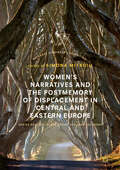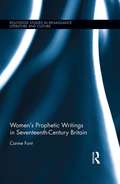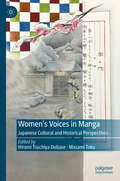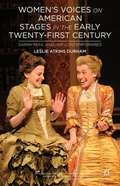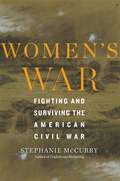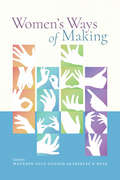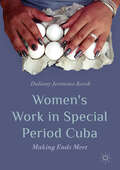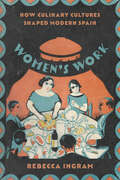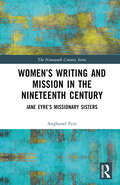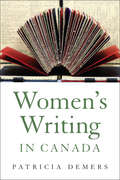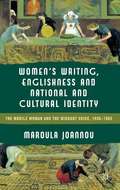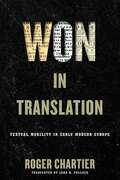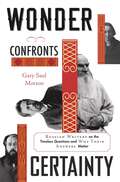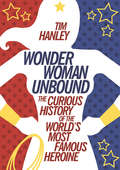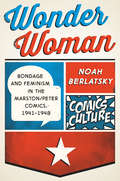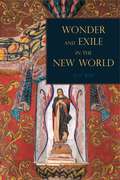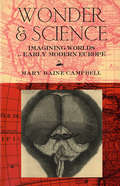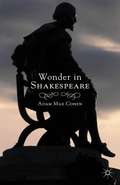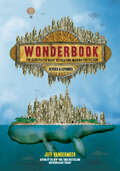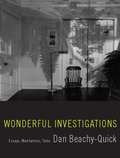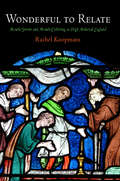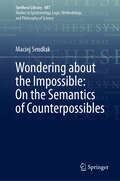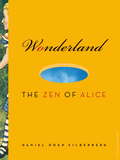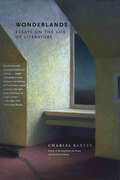- Table View
- List View
Women’s Narratives and the Postmemory of Displacement in Central and Eastern Europe (Palgrave Studies in Life Writing)
by Simona MitroiuThis volume explores the different mechanisms and forms of expression used by women to come to terms with the past, focusing on the variety and complexity of women’s narratives of displacement within the context of Central and Eastern Europe. The first part addresses the quest for personal (post)memory from the perspective of the second and third generations. The touching collaboration established in reconstructing individual and family (post)memories offers invaluable insights into the effects of displacement, coping mechanisms, and resilience. Adopting the idea that the text itself becomes a site of (post)memory, the second part of the volume brings into discussion different sites and develops further this topic in relation to the creative process and visual text. The last part questions the past in relation to trauma and identity displacement in the countries where abusive regimes destroyed social bonds and had a lasting impact on the people lives.
Women’s Prophetic Writings in Seventeenth-Century Britain (Routledge Studies in Renaissance Literature and Culture)
by Carme FontThis study examines women’s prophetic writings in seventeenth-century Britain as the literary outcome of a discourse of social transformation that integrates religious conscience, political participation, and gender identity. The following pages approach prophecy as a culture, a language, and a catalyst for collective change as the individual prophet conceptualized it. While the corpus of prophetic writing continues to grow as the result of archival research, this monograph complements our particular knowledge of women’s prophecy in the seventeenth century with a global assessment of what makes speech prophetic in the first place, and what are the differences and similarities between texts that fall into the prophetic mode. These disparities and commonalities stand out in the radical language of prophecy as well as in the way it creates an authorial centre. Examining how authorship is represented in several configurations of prophetic delivery, such as essays on prophecy, poetic prophecy, spiritual autobiography, and election narratives, the different chapters consider why prophecy peaked in the years of the civil wars and how it evolved towards the eighteenth century. The analyses extrapolate the peculiarities of each case study as being representative of a form of textually-based activism that enabled women to gain a deeper understanding of themselves as creators of independent meaning that empowered them as individuals, citizens, and believers.
Women’s Voices in Manga: Japanese Cultural and Historical Perspectives
by Masami Toku Hiromi Tsuchiya DollaseWomen’s Voices in Manga investigates how manga reflect women's gender issues and social problems within the context of Japanese history, culture, and society. Manga illuminate how women have been treated stereotypically and confined to their gender roles. Fictional characters—surrogates for both creators and readers—have continuously challenged and subverted fixed cultural images, notions, and expressions of women. The first section of the book features research articles on the depiction of women in manga. Contributions of chapters come from scholars in diverse fields, including manga studies, history, art education, literary studies, and gender studies. The second section presents the life stories of prominent women artists Watanabe Masako (b.1929), Mizuno Hideko (b.1939), and Satonaka Machiko (b.1948), capturing their voices and social messages through interviews. Finally, the third section introduces a translated manga, Abe: A Young Woman Emperor-in-Waiting, created by Satonaka Machiko, which features one of the six Japanese female Emperors in history, Kōken Tennō (later Shōtoku Tennō) of the 8th century. Women’s Voices in Manga showcases women’s issues, portrayals, and lives. The book underscores manga’s cultural function to disseminate expressions of women’s issues across society, inviting readers to relate these issues to their own lives.
Women’s Voices on American Stages in the Early Twenty-First Century
by Leslie Atkins DurhamWomen have claimed a spot at the center of American theatre, and the characters they craft, the stories they tell, the questions they pose, and the ideas they materialize have the potential to shape the cultural imagination of a large group of theatre-goers as a complex new era unfolds. Sarah Ruhl is the early twenty-first century's most widely produced and frequently honored American female playwright. While critics have heretofore emphasized the whimsical elements of her dramaturgy, this study highlights her feminist engagement with current social and ethical concerns. Ruhl's popular, feminist plays are best appreciated when they are read in concert with the work of her contemporaries - Lisa Loomer, Diana Son, Joan Didion, Jenny Schwartz, Young Jean Lee, Kate Fodor, Yasmina Reza, Bathsheba Doran, Lynn Nottage, and Kia Corthron - whose writing also wrestles with the vexing issues facing Americans in the new century.
Women’s War: Fighting and Surviving the American Civil War
by Stephanie McCurryThe Civil War is remembered as a war of brother against brother, with women standing innocently on the sidelines. But battlefield realities soon challenged this simplistic understanding of women’s place in war. Stephanie McCurry shows that women were indispensable to the unfolding of the Civil War, as they have been—and continue to be—in all wars.
Women’s Ways of Making
by Maureen Daly Goggin Shirley K RoseWomen’s Ways of Making draws attention to material practices—those that the hands perform—as three epistemologies—an episteme, a techne, and a phronesis—that together give pointed consideration to making as a rhetorical embodied endeavor. Combined, these epistemologies show that making is a form of knowing that (episteme), knowing how (techne), and wisdom-making (phronesis). Since the Enlightenment, embodied knowledge creation has been overlooked, ignored, or disparaged as inferior to other forms of expression or thinking that seem to leave the material world behind. Privileging the hand over the eye, as the work in this collection does, thus problematizes the way in which the eye has been co-opted by thinkers as the mind’s tool of investigation. Contributors to this volume argue that other senses—touch, taste, smell, hearing—are keys to knowing one’s materials. Only when all these ways of knowing are engaged can making be understood as a rhetorical practice. In Women’s Ways of Making contributors explore ideas of making that run the gamut from videos produced by beauty vloggers to zine production and art programs at women’s correctional facilities. Bringing together senior scholars, new voices, and a fresh take on material rhetoric, this book will be of interest to a broad range of readers in composition and rhetoric. Contributors: Angela Clark-Oates, Jane L. Donawerth, Amanda Ellis, Theresa M. Evans, Holly Fulton-Babicke, Bre Garrett, Melissa Greene, Magdelyn Hammong Helwig, Linda Hanson, Jackie Hoermann, Christine Martorana, Aurora Matzke, Jill McCracken, Karen S. Neubauer, Daneryl Nier-Weber, Sherry Rankins-Roberson, Kathleen J. Ryan, Rachael Ryerson, Andrea Severson, Lorin Shellenberger, Carey Smitherman-Clark, Emily Standridge, Charlese Trower, Christy I. Wenger, Hui Wu, Kathleen Blake Yancey
Women’s Work in Special Period Cuba: Making Ends Meet
by Daliany Jerónimo KershThe abrupt loss of Soviet financial support in 1989 resulted in the near-collapse of the Cuban economy, ushering in the almost two decades of austerity measures and severe shortages of food and basic consumer goods referred to as the Special Period. Through the innovative framework of individual and collective memory, Daliany Jerónimo Kersh brings together analysis of press sources and oral histories to offer a compelling portrait of how Cuban women cleverly combined various forms of paid work to make ends meet. Disproportionately impacted by the economic crisis given their role as primary caregivers and household managers and unable to survive on devalued state salaries alone, women often employed informal and illegal earning strategies. As she argues, this regression into gendered work such as cooking, sewing, cleaning, reselling, and providing sexual services precipitated by the post-Soviet crisis to a large extent marked a return to pre-revolutionary gendered divisions of labor.
Women’s Work: How Culinary Cultures Shaped Modern Spain
by Rebecca IngramWe are living in a moment in which famous chefs, Michelin stars, culinary techniques, and gastronomical accolades attract moneyed tourists to Spain from all over the world. This has prompted the Spanish government to declare its cuisine as part of Spanish patrimony. Even with this widespread global attention, we know little about how Spanish cooking became a litmus test for demonstrating Spain's modernity and, relatedly, the roles ascribed to the modern Spanish women responsible for daily cooking.Efforts to articulate a new, modern Spain infiltrated writing in multiple genres and media. Women's Work offers a sharp reading of diverse sources, placed in their historical context, that yields a better understanding of the roles of food within an inherently uneven modernization process. Further, author Rebecca Ingram's perceptive critique reveals the paradoxical messages women have navigated, even in texts about a daily practice that shaped their domestic and work lives. Women's Work posits that this is significant because of the degree to which domestic activities, including cooking, occupied women's daily lives, even while issues like their fitness as citizens and participation in the public sphere were hotly debated. At the same time, progressive intellectuals from diverse backgrounds began to invoke Spanish cooking and eating as one measure of Spanish modernity.Women's Work shows how culinary writing engaged these debates and reached women at the site of much of their daily labor—the kitchen—and, in this way, shaped their thinking about their roles in modernizing Spain.
Women’s Writing and Mission in the Nineteenth Century: Jane Eyre’s Missionary Sisters (The Nineteenth Century Series)
by Angharad EyreUntil now, the missionary plot in Charlotte Brontë’s Jane Eyre has been seen as marginal and anomalous. Despite women missionaries being ubiquitous in the nineteenth century, they appeared to be absent from nineteenth-century literature. As this book demonstrates, though, the female missionary character and narrative was, in fact, present in a range of writings from missionary newsletters and life writing, to canonical Victorian literature, New Woman fiction and women’s college writing. Nineteenth-century women writers wove the tropes of the female missionary figure and plot into their domestic fiction, and the female missionary themes of religious self-sacrifice and heroism formed the subjectivity of these writers and their characters. Offering an alternative narrative for the development of women writers and early feminism, as well as a new reading of Jane Eyre, this book adds to the debate about whether religious women in the nineteenth century could actually be radical and feminist.
Women’s Writing in Canada (Women's Writing in English)
by Patricia DemersSpanning the period from the Massey Commission to the present and reflecting on the media of print, film, and song, this study attends to the burgeoning energy of women writers across genres. It explores how their work interprets our national story. The questioning, disruptive feminist practice of their fiction, filmmaking, poetry, song-writing, drama, and non-fiction reveals the tensions of colonial society at the same time as it transforms cultural life in Canada. Women’s Writing in Canada resurrects foremothers who were active before and after the mid-century – Ethel Wilson, Gabrielle Roy, Gwen Pharis Ringwood, Dorothy Livesay, and P.K. Page – as well as such forgotten writers as Grace Irwin, Patricia Blondal, and Edna Jaques. Its breadth extends to the contemporary voices and influences of novelists Tracey Lindberg and Heather O’Neill, poets Marilyn Dumont and Leanne Betasamosake Simpson, playwrights Hannah Moscovitch and Anna Chatterton, and filmmakers Sarah Polley and Mina Shum. Writing for children as well as memoirs, autobiographies, comic books, and cookbooks illustrate the wide and impressive range of women’s talents.
Women’s Writing, Englishness and National and Cultural Identity
by Maroula JoannouAn original mapping of women's writing in the 1940s and 1950s, this book looks at Englishness and national identity in women's writing and includes writing from Scotland, Wales, Ireland the Indian subcontinent and Africa. The authors discussed include Virginia Woolf, Daphne Du Maurier, Doris Lessing and Muriel Spark.
Won in Translation: Textual Mobility in Early Modern Europe (Material Texts)
by Roger ChartierIn Won in Translation Roger Chartier, one of the world's leading historians of books, publishing, and reading, considers the mobility of the early modern text and the plurality of circulating versions of the same work. The agent for both is translation, for through their lexical, aesthetic, and cultural decisions, translators always assign new meaning or new status to what they translate.Won in Translation proceeds by way of four case studies, three dedicated to works originally in Spanish, the fourth to a Portuguese dramatic adaptation of Don Quixote. Bartolomé de Las Casas' Brevísima relación de la destrucción de las Indias, first printed in 1552, was a powerful instrument for the construction of what was later called the "black legend" of Spanish monarchy. Baltasar Gracián's Oráculo Manual, published in 1647, became the most famous courtier's manual in Europe. Both traveled more widely and were translated more often than any other books of their era. For Chartier they illustrate the great power of translation, which allowed Las Casas' account to be placed in multiple and successive contexts and enabled Gracián's book to take on a range of meanings it had not originally had. Chartier's next two chapters are devoted to plays, one by Lope de Vega, the other by Antônio José da Silva. In the case of Lope's Fuente Ovejuna, the "translation" was one from historical chronicle to dramatic performance. In Antônio José da Silva's Vida do Grande D. Quixote, the textual migration is twofold, as Cervantes' hero moves from Spanish to Portuguese and from novel to play.In an Epilogue, Chartier moves three centuries forward to consider the paradox that it is the absolute immobility of the text, "reinvented" word for word, that creates its mobility in Jorge Luis Borges' fiction "Pierre Menard, Author of the Quixote." Works are transformed through changes of genre or language, to be sure; but even when the texts remain fixed, their readers give them different or inverted meaning.
Wonder Confronts Certainty: Russian Writers on the Timeless Questions and Why Their Answers Matter
by Gary Saul MorsonA noted literary scholar traverses the Russian canon, exploring how realists, idealists, and revolutionaries debated good and evil, moral responsibility, and freedom.Since the age of Tolstoy, Dostoevsky, and Chekhov, Russian literature has posed questions about good and evil, moral responsibility, and human freedom with a clarity and intensity found nowhere else. In this wide-ranging meditation, Gary Saul Morson delineates intellectual debates that have coursed through two centuries of Russian writing, as the greatest thinkers of the empire and then the Soviet Union enchanted readers with their idealism, philosophical insight, and revolutionary fervor.Morson describes the Russian literary tradition as an argument between a radical intelligentsia that uncompromisingly followed ideology down the paths of revolution and violence, and writers who probed ever more deeply into the human condition. The debate concerned what Russians called “the accursed questions”: If there is no God, are good and evil merely human constructs? Should we look for life’s essence in ordinary or extreme conditions? Are individual minds best understood in terms of an overarching theory or, as Tolstoy thought, by tracing the “tiny alternations of consciousness”? Exploring apologia for bloodshed, Morson adapts Mikhail Bakhtin’s concept of the non-alibi—the idea that one cannot escape or displace responsibility for one’s actions. And, throughout, Morson isolates a characteristic theme of Russian culture: how the aspiration to relieve profound suffering can lead to either heartfelt empathy or bloodthirsty tyranny.What emerges is a contest between unyielding dogmatism and open-minded dialogue, between heady certainty and a humble sense of wonder at the world’s elusive complexity—a thought-provoking journey into inescapable questions.
Wonder Woman Unbound: The Curious History of the World's Most Famous Heroine
by Tim HanleyWith her golden lasso and her bullet-deflecting bracelets, Wonder Woman is a beloved icon of female strength in a world of male superheroes. But this close look at her history portrays a complicated heroine who is more than just a female Superman. The original Wonder Woman was ahead of her time, advocating female superiority and the benefits of matriarchy in the 1940s. At the same time, her creator filled the comics with titillating bondage imagery, and Wonder Woman was tied up as often as she saved the world. In the 1950s, Wonder Woman begrudgingly continued her superheroic mission, wishing she could settle down with her boyfriend instead, all while continually hinting at hidden lesbian leanings. While other female characters stepped forward as women's lib took off in the late 1960s, Wonder Woman fell backwards, losing her superpowers and flitting from man to man. Ms. magazine and Lynda Carter restored Wonder Woman's feminist strength in the 1970s, turning her into a powerful symbol as her checkered past was quickly forgotten. Exploring this lost history as well as her modern incarnations adds new dimensions to the world's most beloved female character, and Wonder Woman Unbound delves into her comic book and its spin-offs as well as the myriad motivations of her creators to showcase the peculiar journey that led to Wonder Woman's iconic status.
Wonder Woman: New edition with full color illustrations
by Noah BerlatskyWilliam Marston was an unusual man—a psychologist, a soft-porn pulp novelist, more than a bit of a carny, and the (self-declared) inventor of the lie detector. He was also the creator of Wonder Woman, the comic that he used to express two of his greatest passions: feminism and women in bondage. Comics expert Noah Berlatsky takes us on a wild ride through the Wonder Woman comics of the 1940s, vividly illustrating how Marston’s many quirks and contradictions, along with the odd disproportionate composition created by illustrator Harry Peter, produced a comic that was radically ahead of its time in terms of its bold presentation of female power and sexuality. Himself a committed polyamorist, Marston created a universe that was friendly to queer sexualities and lifestyles, from kink to lesbianism to cross-dressing. Written with a deep affection for the fantastically pulpy elements of the early Wonder Woman comics, from invisible jets to giant multi-lunged space kangaroos, the book also reveals how the comic addressed serious, even taboo issues like rape and incest.Wonder Woman: Bondage and Feminism in the Marston/Peter Comics 1941-1948 reveals how illustrator and writer came together to create a unique, visionary work of art, filled with bizarre ambition, revolutionary fervor, and love, far different from the action hero symbol of the feminist movement many of us recall from television.
Wonder and Exile in the New World
by Alex NavaIn Wonder and Exile in the New World, Alex Nava explores the border regions between wonder and exile, particularly in relation to the New World. It traces the preoccupation with the concept of wonder in the history of the Americas, beginning with the first European encounters, goes on to investigate later representations in the Baroque age, and ultimately enters the twentieth century with the emergence of so-called magical realism. In telling the story of wonder in the New World, Nava gives special attention to the part it played in the history of violence and exile, either as a force that supported and reinforced the Conquest or as a voice of resistance and decolonization. Focusing on the work of New World explorers, writers, and poets—and their literary descendants—Nava finds that wonder and exile have been two of the most significant metaphors within Latin American cultural, literary, and religious representations. Beginning with the period of the Conquest, especially with Cabeza de Vaca and Las Casas, continuing through the Baroque with Cervantes and Sor Juana Inés de la Cruz, and moving into the twentieth century with Alejo Carpentier and Miguel Ángel Asturias, Nava produces a historical study of Latin American narrative in which religious and theological perspectives figure prominently.
Wonder and Exile in the New World
by Alex NavaIn Wonder and Exile in the New World, Alex Nava explores the border regions between wonder and exile, particularly in relation to the New World. It traces the preoccupation with the concept of wonder in the history of the Americas, beginning with the first European encounters, goes on to investigate later representations in the Baroque age, and ultimately enters the twentieth century with the emergence of so-called magical realism. In telling the story of wonder in the New World, Nava gives special attention to the part it played in the history of violence and exile, either as a force that supported and reinforced the Conquest or as a voice of resistance and decolonization. Focusing on the work of New World explorers, writers, and poets—and their literary descendants—Nava finds that wonder and exile have been two of the most significant metaphors within Latin American cultural, literary, and religious representations. Beginning with the period of the Conquest, especially with Cabeza de Vaca and Las Casas, continuing through the Baroque with Cervantes and Sor Juana Inés de la Cruz, and moving into the twentieth century with Alejo Carpentier and Miguel Ángel Asturias, Nava produces a historical study of Latin American narrative in which religious and theological perspectives figure prominently.
Wonder and Science: Imagining Worlds in Early Modern Europe
by Mary Blaine CampbellDuring the early modern period, western Europe was transformed by the proliferation of new worlds—geographic worlds found in the voyages of discovery and conceptual and celestial worlds opened by natural philosophy, or science. The response to incredible overseas encounters and to the profound technological, religious, economic, and intellectual changes occurring in Europe was one of nearly overwhelming wonder, expressed in a rich variety of texts. In the need to manage this wonder, to harness this imaginative overabundance, Mary Baine Campbell finds both the sensational beauty of early scientific works and the beginnings of the divergence of the sciences—particularly geography, astronomy, and anthropology—from the writing of fiction. Campbell's learned and brilliantly perceptive new book analyzes a cross section of texts in which worlds were made and unmade; these texts include cosmographies, colonial reports, works of natural philosophy and natural history, fantastic voyages, exotic fictions, and confessions. Among the authors she discusses are André Thevet, Thomas Hariot, Francis Bacon, Galileo, Margaret Cavendish, and Aphra Behn. Campbell's emphasis is on developments in England and France, but she considers works in languages other than English or French which were well known in the polyglot book culture of the time. With over thirty well-chosen illustrations, Wonder and Science enhances our understanding of the culture of early modern Europe, the history of science, and the development of literary forms, including the novel and ethnography.
Wonder in Shakespeare
by Adam Max CohenIn the first part of this book, Adam Max Cohen embraces the many meanings of wonder in order to challenge the generic divides between comedy, tragedy, history, and romance and suggests that Shakespeare's primary goal in crafting each of his playworlds was the evocation of one or more varieties of wonder.
Wonderbook: The Illustrated Guide to Creating Imaginative Fiction
by Jeff VanderMeerNow expanded: The definitive visual guide to writing science fiction and fantasy—with exercises, diagrams, essays by superstar authors, and more. From the New York Times-bestselling, Nebula Award-winning author, Wonderbook has become the definitive guide to writing science fiction and fantasy by offering an accessible, example-rich approach that emphasizes the importance of playfulness as well as pragmatism. It also embraces the visual nature of genre culture and employs bold, full-color drawings, maps, renderings, and visualizations to stimulate creative thinking. On top of all that, it features sidebars and essays—most original to the book—from some of the biggest names working in the field today, among them George R. R. Martin, Lev Grossman, Neil Gaiman, Michael Moorcock, Charles Yu, Kim Stanley Robinson, and Karen Joy Fowler. For the fifth anniversary of the original publication, Jeff VanderMeer has added fifty more pages of diagrams, illustrations, and writing exercises, creating the ultimate volume of inspiring advice. &“One book that every speculative fiction writer should read to learn about proper worldbuilding.&” —Bustle &“A treat . . . gorgeous to page through.&” —Space.com
Wonderful Investigations
by Dan Beachy-QuickOver the course of six critically acclaimed books-including a compelling meditation on Moby-Dick-Dan Beachy-Quick has established himself as "one of America's most significant young poets" (Lyn Hejinian).In Wonderful Investigations, Beachy-Quick broaches "a hazy line, a faulty boundary" between our daily world and one rich with wonder; a magical world in which, through his work as a writer, Beachy-Quick participates with a singular combination of critical intelligence and lyricism. Touching on the works of Emerson, Thoreau, Proust, and Plato, among others, Beachy-Quick outlines the problem of duality in modern thought-the separation of the mind and body, word and referent, intelligence and mystery, human and natural-and makes the case for a fuller kind of nature poetry, one that strives to overcome this false separation, and to celebrate the notion that "wonder is the fact that the world has never ceased to be real."
Wonderful to Relate: Miracle Stories and Miracle Collecting in High Medieval England (The Middle Ages Series)
by Rachel KoopmansWhile the late Anglo-Saxons rarely recorded saints' posthumous miracles, a shift occurred as monastic writers of the late eleventh and twelfth centuries started to preserve hundreds of the stories they had heard of healings, acts of vengeance, resurrections, recoveries, and other miraculous deeds effected by their local saints. Indeed, Rachel Koopmans contends, the miracle collection quickly became a defining genre of high medieval English monastic culture.Koopmans surveys more than seventy-five collections and offers a new model for understanding how miracle stories were generated, circulated, and replicated. She argues that orally exchanged narratives carried far more propagandistic power than those preserved in manuscripts; stresses the literary and memorial roles of miracle collecting; and traces changes in form and content as the focus of the collectors shifted from the stories told by religious colleagues to those told by lay visitors to their churches.Wonderful to Relate highlights the importance of the two massive collections written by Benedict of Peterborough and William of Canterbury in the wake of the murder of Thomas Becket in 1170. Koopmans provides the first in-depth examination of the creation and influence of the Becket compilations, often deemed the greatest of all medieval miracle collections. In a final section, she ponders the decline of miracle collecting in the thirteenth century, which occurred with the advent of formalized canonization procedures and theological means of engaging with the miraculous.
Wondering about the Impossible: On the Semantics of Counterpossibles (Synthese Library #487)
by Maciej SendłakThis book provides an in-depth analysis of the nature and role of hypothetical reasoning about impossibilities. The interest in this subject stems from the simple observation that wondering is an inherent aspect of our experience. Whether one regrets choosing a taxicab over the subway or contemplates the outcome of an election turning out differently, the question 'What would have happened if...?' is a familiar one. While we often focus on possible scenarios, we also ponder impossible ones: What if whales were fish? What if a man could be in two places at once? What if one could draw a round square? Puzzles concerning such questions sparked a heated discussion over the nature and role of hypothetical reasoning about impossibilities. This book goes beyond being an opinionated introduction to this debate. After comparing various approaches to this issue, it proposes a novel perspective that draws on considerations from epistemology and the philosophy of explanation and dependence. Targeting researchers and students interested in the philosophy of modalities, this book delivers an in-depth analysis of a captivating and often overlooked aspect of human reasoning.
Wonderland
by Daniel Doen SilberbergAn exceptionally original riff on Alice in Wonderland, Daniel Silberberg's Wonderland uses Lewis Carroll's classic story as a jumping-off point to convey the Zen concept of "One Mind". Using a lively mix of tone, quotation, and levels of discourse, he references everything from Timeless Spring and the Diamond Sutra to Kill Bill and ketchup, creating a unique contribution to contemporary American Zen that honors its historic roots while striking out into fresh areas. With stories from his own life as well as from the larger cultural swirl around him, Silberberg reflects on the differences between how we perceive the world and the way it actually is. His take on a variety of Buddhist ideas and concepts is immediately useful and relevant, enabling readers to address many of the issues they deal with in their own practices.
Wonderlands: Essays on the Life of Literature
by Charles BaxterSearching and erudite new essays on writing from the author of Burning Down the House.Charles Baxter’s new collection of essays, Wonderlands, joins his other works of nonfiction, Burning Down the House and The Art of Subtext. In the mold of those books, Baxter shares years of wisdom and reflection on what makes fiction work, including essays that were first given as craft talks at the Bread Loaf Writers’ Conference.The essays here range from brilliant thinking on the nature of wonderlands in the fiction of Haruki Murakami and other fabulist writers, to how request moments function in a story. Baxter is equally at home tackling a thorny matter such as charisma (which intersects with political figures like the disastrous forty-fifth US president) as he is bringing new interest to subjects such as list-making in fiction.Amid these craft essays, an interlude of two personal essays—the story of a horrifying car crash and an introspective “letter to a young poet”—add to the intimate nature of the book. The final essay reflects on a lifetime of writing, and closes with a memorable image of Baxter as a boy, waiting at the window for a parent who never arrives and filling that absence with stories. Wonderlands will stand alongside his prior work as an insightful and lasting work of criticism.
